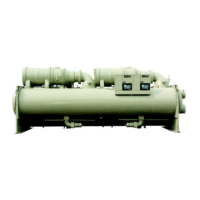56 Product Manual PM WSC/WDC
Application Considerations
Pumps
Model WSC and WDC chiller compressor motors operate at 3600 rpm at 60 Hz (3000 rpm at 50 Hz). To avoid the
possibility of objectionable harmonics in the system piping, the use of 3600 (3000) rpm system pumps should be
avoided. The condenser water pump(s) must be cycled off when the last chiller of the system cycles off. This
will help to maintain proper separation of oil and refrigerant within the chiller. In addition, turning off the
condenser water pump(s) when the chillers are not operating will conserve energy.
Evaporator Water Temperature
If used as chilled water, the temperature of system heating water should not exceed 110°F (43.3°C) when
introduced into the evaporator.
System Water Volume
All chillers need adequate time to recognize a load change, respond to the load change and stabilize without
short-cycling the compressor. There is a distinct relationship between the minimum capacity of the chiller plant,
the system minimum expected capacity, system water volume, the desired interval between starts, and the dead
band of the chiller controller-the number of degrees between shut off and turn on. McQuay centrifugal chillers
unload to 10% (5% for dual compressor units), have as little as 20 minutes between starts (adjustable from 60 to
20 minutes), and a factory default value of 6 degrees F of chilled water temperature between shut off and restart
(adjustable 2 to 20°F). There must be sufficient time/volume when the compressor is running with more capacity
than system load, plus sufficient time/volume for the compressor to be off during the required anti-cycle time.
These relationships are expressed in the following formula:
+
−
=
221
500
H
TD
HH
TD
TS
V
Where: V = Total system U.S. gallons TS = Time between starts (min)
TD = Dead band range of controller (°F) H1 = Chiller minimum capacity (btu/hr)
H2 = Minimum system capacity (btu/hr)
Condenser Water Temperature
When ambient wet bulb temperature are lower than design, the entering condenser water temperature may be
allowed to fall. Lower temperatures, to a predetermined minimum, improve chiller performance.
Normally, McQuay centrifugal chillers will start with entering condenser water temperature of 55°F (42.8°C).
During normal operation the minimum entering condenser water temperature (assuming 3 gpm per ton flow) is a
function of the leaving chilled water temperature and load. The table below gives the approximate minimum
condenser water temperatures as a function of these variables. These values may be lower in mild climates and
low wet bulb areas.
Depending on local climatic conditions, using the lowest possible entering condenser water temperature may be
more costly in total system power consumed than the expected savings in chiller power would suggest due to
the excessive fan power required.

